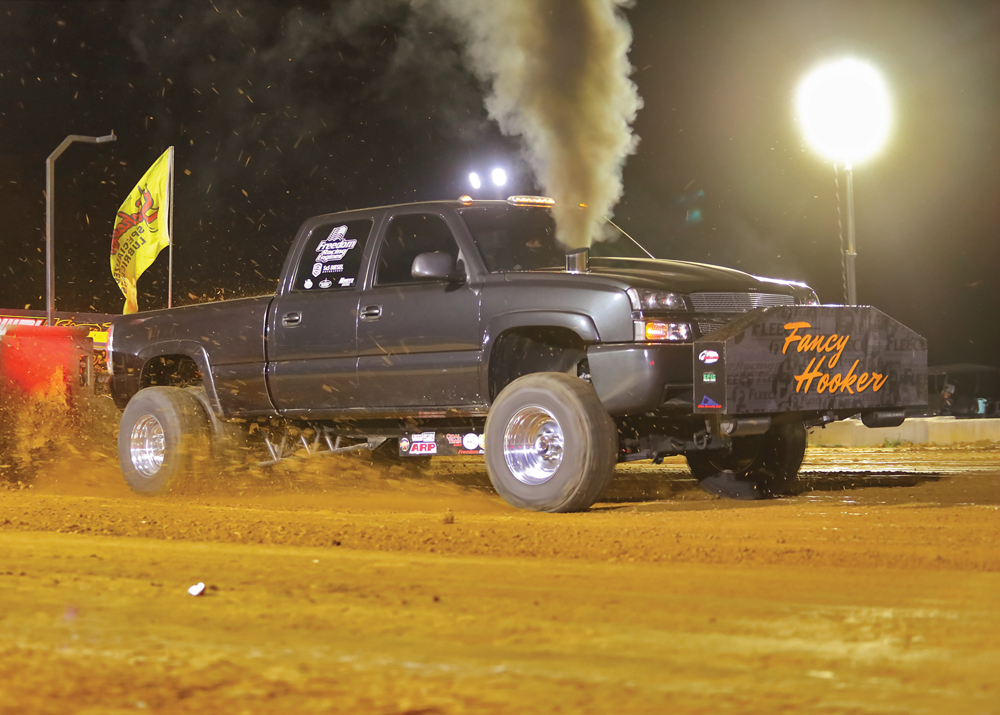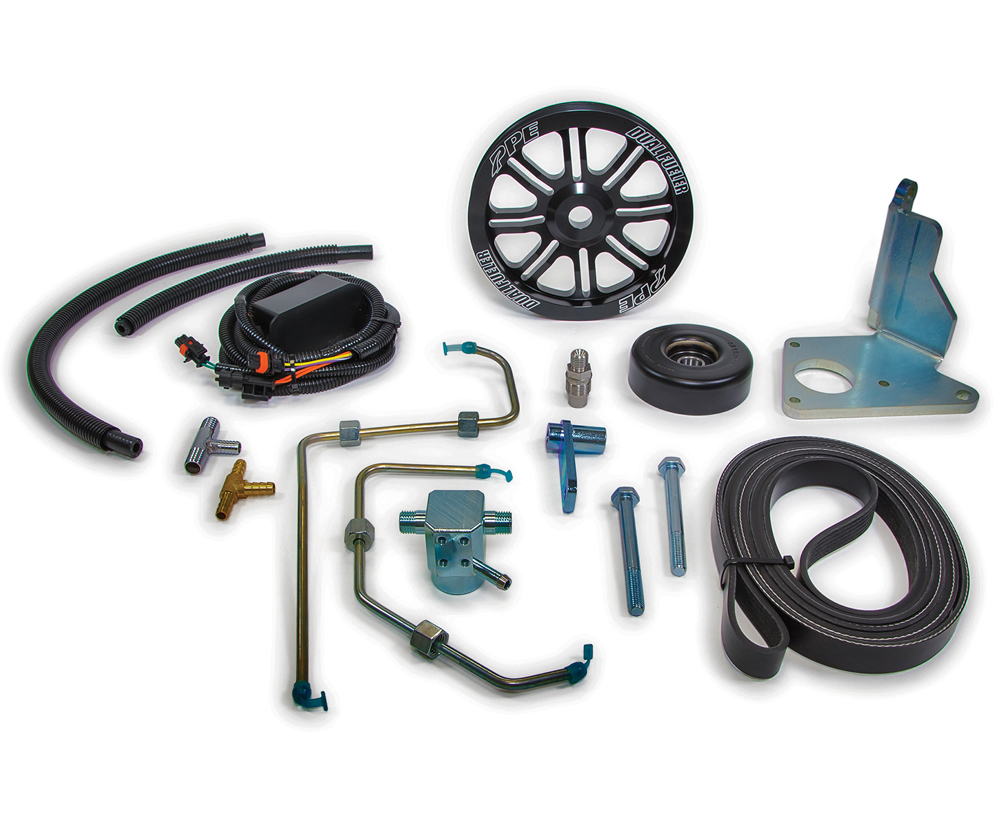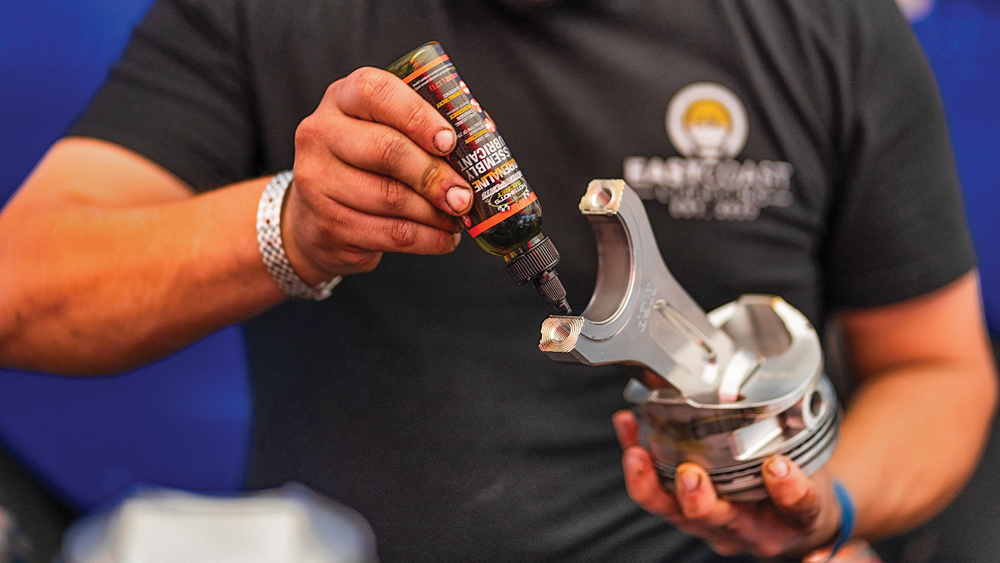Gaining Ground

Photo courtesy of Hot Shot’s Secret
Raw horsepower draws fans and manufacturers to straight-line dirt competition that has expanded beyond America’s Heartland.
At its most basic, the sport of pulling reflects the conflicts of physics at their most elemental and earsplitting level. It’s almost a colosseum-type experience, the action unfolding on a few hundred feet of groomed dirt in front of grandstands whose spectators can nearly reach out and touch the vehicles. The competition is pure grunt work, getting tonnage to budge from a dead stop as the effort to move all that weight gets progressively more difficult.
It’s a ritual of performance that can trace its origins back to when tractors first replaced horses, as the nation’s farmers labored to till their acreage around the turn of the 20th century. Pulling, to use its shorthand name, is now a vibrant genre of American motorsports, practiced in venues that vary from county fairgrounds to indoor sports arenas. It has parallels to drag racing, except that pulling is contested on a compact dirt surface in front of even more closely gathered spectators. And it’s indeed a spectacle. With the possible exception of nitro-fueled drag racing, no other brand of North American motorsports provides the sort of thunderous, torque-crazed competition that pulling—it’s not just “tractor pulling” anymore—delivers to its fans all over the United States.
It’s also a buzzy phenomenon in the world of modern automotive competition. Combine enthusiastic participants with equally amped spectators and enough raw power to seemingly bump the Earth off its axis, and it becomes clear that pulling represents unique opportunities for both technological advancement and grabbing the public’s attention. Pulling’s gone big today. It’s still a rural pastime at its most elemental, but this struggle between machine and ground now enjoys markedly broadened appeal in locales that aren’t necessarily out in the countryside. And again, a lot like drag racing, even street-legal vehicles can credibly participate.
Pulling Basics
To help explain its booming appeal, PRI reached out to a key presence in the pulling world, because he’s been organizing events for years. Richard Love is the proprietor of Pennsylvania-based Full Pull Productions, which now sanctions some 100 pulling events annually. They take place largely in the eastern United States, including in New York, which is a surprisingly strong hotbed for the sport today.
“Pulling in its early history started with tractors. It was a farmer-based motorsport, and over the years, trucks got involved,” Love said. “People who are into pulling basically fall into three classes: The farmer type who’s familiar with tractors is the first. Then there’s the 18- to 30-year-olds, the young kids in the diesel world just starting to get involved, and now the big rigs, appealing to truckers who are into grassroots motorsports. It’s still largely a rural sport, but it’s not necessarily about farming anymore.”
Love is well qualified to give an overview of pulling and its processes. Full Pull Productions presents pulling from an even dozen classes, running from moderately modified, street-legal diesel pickups to modified tractors powered by performance automotive V8s to Limited Pro Tractors, the kind that might have originally plowed a field, only now fitted with turbocharged diesel engines and running at a weight of up to 9,000 pounds. All of them take part in the action of moving the weighted sled from one end of the track to the other, an achievement that’s celebrated as a “full pull.” There’s also a highly popular Full Pull class for big rigs, matching beefed-up Class 8 highway trucks in competition.
What is pulling? It’s a motorized contest that takes place over a manicured dirt surface that’s at least 30 feet wide and 320 feet long, but often larger.
Love is also versed in what happens next, because Full Pull also designs and builds the pulling sleds that are integral to the sport. A sled essentially attaches to the drawbar of a pulling vehicle. When the start flag is waved, the pulling vehicle moves out on the groomed dirt pulling course, and the weight box atop the sled—the weight varies by class—begins moving forward, driven by gears that pull the weight box up and forward along the sled’s frame rails. An electronic trip mechanism then lets the sled’s hydraulically controlled weight pan drop toward the ground, where bars at the bottom of the pan will dig into the track surface. The amount of resistance increases with distance. The physical weight on the sled is 25,000 pounds, and as Love explained, the sled transfers 500% of that weight forward during the pull. The competitor whose rig pulls the sled the farthest is declared the winner of the pull.
Parts In Demand
This kind of action occurs hundreds of times per year across multiple classes and sanctioning bodies. Pulling’s popularity has led to a universe of specialty products aimed at maximizing this exercise in pure torque and horsepower. This new audience provides extensive marketing opportunities to not only promote products, but to engage the attention of the sport’s growing spectator base. One of the most prominent suppliers in the pulling world is Pacific Performance Engineering (PPE) of North Las Vegas, Nevada, which has a strong working relationship with another pull organizer, the National Association of Diesel Motorsports (NADM) in Kansas City, Missouri.
PPE’s business, and NADM’s contests, revolve primarily around modified diesel pickups. As PPE’s Eric Sempson explained, “Pulling is probably 30 to 40% of our business. Our equipment is going to be for a Chevrolet or GMC Duramax 6.6-liter turbocharged diesel.” A key component in PPE’s inventory is its Dual Fueler pumping system, for Duramax and other diesels, which Sempson said “provides redundancy for the factory fuel pump, allows improved fuel flow, and also allows the fuel pressure to be consistent.” It’s a bolt-on component, available for 15 years now, that does not require dyno tuning. Available horsepower for a Duramax can range from 500 to 2,000 hp, depending on equipment. PPE also produces transmission coolers, transmission pumps, transmission pans, and differential covers, with these components aimed at all three major diesel engines for light trucks: Duramax, Navistar, and Cummins.

PPE markets extensively, starting with its sponsorship of NADM, where its Dual Fueler is the group’s official fueling system for pulling-class pickups. “In terms of marketing, we do Instagram, Tik Tok, we advertise in Diesel Power magazine, we have banners at the track, and we do YouTube videos. Different media come to us, and we do hands-on videos, like installations, and cover all the bases we can. We’re also a National Hot Rod Diesel Association participant, primarily with diesel trucks.”
Larger and heavier pulling vehicles can find a performance partner at Hart’s Diesel and Machine in Fayette, Missouri. Roger Conley said much of Hart’s work involves turbochargers and fuel systems for larger diesel pullers, such as Pro Stock tractors. “That class is the big one now,” Conley said. “We supply premium turbo and fuel systems for all tractors in the diesel environment. We supply complete injectors, pumps, lines, all dyno’d for the application. It’s a very dynamic range. Our smallest turbo on the dyno might make 1,500 hp, whereas the Pro Stock turbo might make 5,000. What makes Hart’s unique is that in this R&D process, we machine every single component of each turbo right in our building, including the manufacturing of compressor wheels. The same applies to our fuel systems, which are custom high end with billet pumps. We had to build a giant pump dyno with electric power to test them, the only one in the world. You can’t have a good turbo without a good fuel system because you’ll just burn the engine up.”
What about marketing? In Conley’s view, “We do it the old-fashioned way. We just go out there and run.” He noted that a recent major indoor pull at Shipshewana, Michigan, drew 420 pulling tractors, and 372 of them were Hart’s-equipped. “We do some social media, and go to the PRI Show, but the pulling world is one of the tightest communities I’ve ever encountered in my 40 years in the aftermarket industry. Pulling is continuing to advance, in terms of using software, firmware, scanners, and 3D printers in product development. We’re using that technology to move pulling forward.”
In terms of direct sales, the market for pulling engines and components is a small element of overall business for Fleece Performance Engineering in Pittsboro, Indiana, which produces custom engines, engine kits, and hardened components, largely for wholesalers and diesel repair shops. Pulling, however, is an integral part of Fleece’s test lab for creating new products that aren’t necessarily pulling-related.

“We sell a stock Cummins cylinder head, but a lot of the technology in that stock head is derived from trying to make the head live in a pulling truck,” said John Benshoof. “Although it’s got a different valve size or spring rate, we’re able to take those concepts and apply them backward to our everyday products, and in turn put the best product we can on the market.”
Fleece’s “bread and butter,” as Benshoof described it, is components for pulling trucks running in classes that mandate maximum turbocharger inlets of 2.6 and 3.0 inches. Fleece specializes in both parts and complete engines for both of those pulling categories.
“Our customers are looking for high-quality products that solve problems, and we try to do that as elegantly as we can,” Benshoof continued. “Pulling is just a sliver of our overall business, but we look at all motorsports as a way to market our brand, and at these pulls, people will see our products as the best of the best. We sold more engines this year for the pulling market than we ever have in the past. In my opinion, it is interesting to see how much more refined the sport has gotten just in the past 10 years.”
The insane output of an all-out pulling engine means that proper lubrication is absolutely critical to avoiding a part-spewing disaster. Hot Shot’s Secret in Mount Gilead, Ohio, is in the business of providing specially formulated additives for extreme-service powerplants. Josh Steinmetz came to the firm with a strong working knowledge of pulling requirements, having spent a dozen years with the National Tractor Pulling Association (NTPA). Hot Shot’s takes on the world of pulling with its Adrenaline line of severe-service oil and fuel additives. As Steinmetz explained, Hot Shot’s additives are exclusively formulated using Group 4 poly-alpha-olefin, which are full-synthetic oils using a non-polar polymer as their basis.

“A Pro Stock tractor has a maximum of 3,800 to 4,000 hp from an engine that originally made 130 hp,” Steinmetz explained. “You usually see a lot of valvetrain failure, or else a blower belt or turbo comes apart from heat and pressure. There’s a lot of shock loading, as well, so you also have a lot of driveline issues. So the Adrenaline line also includes gear additives, as well. We do see sometimes where it’s really tough because you’re applying such a shock load all at once.
“As you increase the engine’s power, the lubricity’s effect is usually the exact opposite,” he said. “If you’re running a lot of fuel at extreme pressure, the fuel is acting as a lubricant for the pump and injectors. Having [Adrenaline additives] is a really nice option, because it’s cost efficient, and you get the power and protection you need to keep things running a long time.”
Building the Sport
Today, pulling presents similar opportunities to those of drag racing when it comes to audience participation, or simply finding new competitor interest. The NADM now does eight major regional events a year, but Ron Knoch said the sport’s appeal is far more extensive than that.

“It’s big. Starting the first week of June to the end of August, you can find sled pulling at local, state, and county fairs practically six days out of the week, every night, in each state, from Kansas all the way to New York. That’s how big it is,” he explained. “We concentrate on the farm belt for our events because that’s where the trucks are. We are mainly 3/4-ton and 1-ton pickups, so that means we’re looking for street trucks, with a few tractor classes.”
Knoch said he and the association are fully committed to attracting new participants to pulling, and the NADM has been successful at sponsor relations for its entire existence. “The reason is that the competitors use our sponsors’ products. If you want to build the sport, you have to attract the local people with street trucks who are interested in pulling. Once you do, they want to increase the truck’s output and go to one of the bigger classes. But first, you have to get them started, and the only way to get them started is in street truck.
“You know what? A stock truck can be a puller,” Knoch said. “You can set the sled where’s it’s a 5,000-pound pull, which is the normal pulling tongue weight of the trailer. So if you can pull a 5,000-pound trailer, you can go sled pulling. Our categories today go from factory stock to highly modified. All of our sponsors are major manufacturers: ARP, MAHLE Motorsport, Callies, Total Seal, AutoMeter, PPE, Amsoil, Thermo-Tec. All the sponsors produce performance replacement parts that are all CARB approved for 50 states and have EPA numbers, so they’re legal for use on street vehicles. At the events, we have a sponsor tent full of equipment and literature, so the fans and competitors can learn what’s new and how they can benefit from purchasing the products.”
SOURCES
Fleece Performance Engineering
fleeceperformance.com
Full Pull Productions
fullpullproductions.com
Hart’s Diesel & Machine
hartsdiesel.com
Hot Shot’s Secret
hotshotsecret.com
National Association of Diesel Motorsports
dieselmotorsports.us
Pacific Performance Engineering
ppepower.com
 MEMBERSHIP LOGIN
MEMBERSHIP LOGIN JOIN PRI
JOIN PRI


